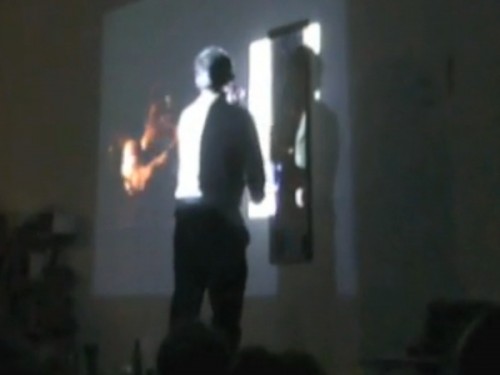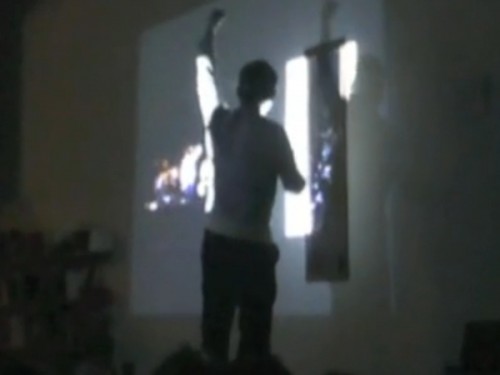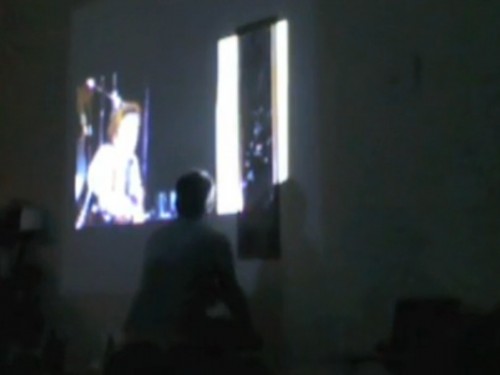On January 27, 2013 Seth Kim-Cohen gave a new performance titled The bee in bathos equals the pee in pathos (except at the bathhouse) at The Postscript Symposium, a two-day showcase of performances and presentations featuring local, national, and international artists in the Museum of Contemporary Art Denver exhibition Postscript: Writing After Conceptual Art. Co-curated by Nora Burnett Abrams and Andrea Andersson, the exhibition presented works from the 1960s to the present—including painting, sculpture, installation, video, and works on paper—that raise questions about how we read, look at, hear, and process language today.
Kim-Cohen is a full-time visiting artist at the School of the Museum of Fine Arts, Boston. Many of his projects initiate a listening about and around rock music as a cultural signifier. As a theorist he has published In The Blink of an Ear: Toward a Non-Cochlear Sonic Art (Continuum, 2009), and One Reason To Live: Conversations About Music (Errant Bodies, 2006). His work has been presented at venues on three continents, including: Audio Visual Arts, Issue Project Room, Diapason Gallery, and PS122 in New York; Tate Modern, the ICA, Whitechapel Gallery, and Peer Gallery in London; the ZKM in Karlsruhe, Germany; Kino Siska in Ljubljana, Slovenia; and the Singapore Biennial. From 1990 to 2002, he wrote, recorded and performed in a series of increasingly experimental rock bands, including Number One Cup and The Fire Show, with whom he released seven albums and numerous shorter recordings; played throughout the U.S., U.K., Canada, and Europe; and recorded two Peel Sessions.
Following is an interview with Kim-Cohen focused on The bee in bathos equals the pee in pathos (except at the bathhouse).
Amelia Ishmael: What happened during The bee in bathos equals the pee in pathos (except at the bathhouse)?
Seth Kim-Cohen: The bee in bathos equals the pee in pathos (except at the bathhouse) maps the narration style of Dan Graham’s Performer/Audience/Mirror to video documentation of the final song of the final performance of the Sex Pistols’ career. I wouldn’t argue with anyone claiming that this is an arbitrary confabulation. But perhaps it mitigates such a claim if I point out that these two legendary performances both took place in San Francisco only three years apart—Graham in 1975, the Pistols in 1978. Then again, arbitrary confabulations are my stock in trade.
A video of the Pistols performing the Stooges’ “No Fun” is projected on the wall. To the right of the frame a vertical strip of white light is projected on a mirror. As Johnny Rotten takes the stage, I leap onto a table, framing myself in the strip of white light and facing the mirror, while I mimic Rotten’s gestures and movements. Adopting Dan Graham’s style, tone, and some of his phrases, I narrate Rotten’s movements in the first person, throughout the seven and a half minutes of the song.
AI: You leapt on the table?!
SKC: Yes. Somewhat awkwardly, as you see in the video, kind of clambering and teetering and nearly falling. But I’m sticking to my original answer: I leaped.

Seth Kim-Cohen, “The bee in bathos equals the pee in pathos (except at the bathhouse)” performance still, January 2013.
AI: Some of the writing that you’ve been up to…and your presentation “Burden Bangs Joy: The Problem of a Rock and Roll Aesthetic” at the Sound Art Theories Symposium (2011)…involves a discussion of the aesthetics of Rock. In this case, you’re dealing with Punk of course. Was some of the inspiration for this piece a desire to further analyze and understand Rotten’s (mythic) live performance? And the extra-musical situation of live performances?
SKC: I don’t know that there’s much analysis involved. I think I’m trying to relate to this pathetic episode, this horrible ending to a story that was so pivotal, so productive, so revisionist, so fucked up. “Relating” is a key word for me. I think that when you boil art down to its indispensable components, what you’re left with are relations: of artist to audience, artist to materials, audience to materials, audience to audience, everyone to history, etc. Such relations are the only consistent component in all works of art. (Of course, they’re consistently present in all human activities. But maybe that tells us something else about art.)
AI: When I first saw your performance, my initial response was, I guess, shock at how you were playing with what was going on in the Sex Pistols video. The first time I saw this video documentation of the Winterland concert was within the documentary video The Filth and the Fury and I was really empathetic to the original performance and how fucked up the whole situation was—how the Sex Pistols had gone through this arc of making original artistic statements that were eventually turned into a gimmick, codified and commercialized as the Punk movement gained further international attention. I thought your performance was profane at first, but then I started to appreciate how you were, in a way, breathing new life into the situation. How does humor work within this performance?
SKC: First, I think the truth of the Sex Pistols’ story is more complicated than that. Each player had different—but overlapping—motives. Malcolm McLaren wanted to generate rebellion in order to codify and commodify the absurdity of that rebellion. That, in itself, is a pretty complicated scheme. Steve Jones just wanted to play music and “get away” with it (i.e., be the clown/thug he always was, but somehow turn that into a career). Sid Vicious wanted to be a rock star in the worst sense of the phrase. John Lydon’s motivations are, to my mind, not as clear, primarily because I think they changed in the 18 months that the Pistols were a band. In other words, I think, of all of them, only Lydon expanded his vision of his project during the band’s existence. This makes him the hero of the story. I think he started with motivations close to Jones’s, moved through McLaren’s piss-take on art and commerce, and came to think that art was the only refuge from the criminal debasement of values based on something other than exchange. When Lydon left the Pistols and especially on the second and third PiL albums, I think he truly embraced the idea of a radical aesthetic as a vehicle for a philosophic/ economic/cultural/historical shift. (What came after that is a different story again.) In the Winterland performance you can see the wheels already turning in his head. During the last song, the encore, the cover of the Stooges’ “No Fun,” you can practically witness him making up his mind, changing right before our eyes. He sings the words “no fun” as a kind of double entendre. The phrase is both a quotation of the Stooges’ and a statement of fact. “This is no fun.” Pete Townshend said of the Pistols: “When you listen to the Sex Pistols, to ‘Anarchy in the U.K.’ and ‘Bodies’ and tracks like that, what immediately strikes you is that this is actually happening.” This is what he meant. When Lydon and Rotten sing “no fun” it ain’t just the words to a song. It is that too. But it is also a live, real-time statement of fact. And that truth of what you call “the performance situation” is so crucial. In the best instances, rock performances, for all their performativity, are statements of fact.
As for humor, I’m with Lester Bangs who called rock and roll the greatest super-joke in history. Bangs didn’t mean that rock was a silly throwaway like a Jim Carrey movie or Conan O’Brien. He was thinking like Nietzsche: that humor is the symptom of the deep and unfathomable abyss at the center of human existence. We shout “I am here” into the void, and from the void the response comes: “hah hah hah.”

Seth Kim-Cohen, “The bee in bathos equals the pee in pathos (except at the bathhouse)” performance still, January 2013.
AI: How does being in a museum setting, with the MCA Denver, and including recognizable references to figures in contemporary fine art, with Dan Graham, change how Punk is thought of?
SKC: Graham loves punk. So I don’t want to make divisions where there aren’t any. He made the film Minor Threat in 1983. Still, I recognize that the audience at such an event may be more intimately familiar with the nuances of Dan Graham’s work than with the Sex Pistols. By mapping one to the other, I’m merely reflecting my relation (there’s that word again) to the two bodies of work, to the equivalence of their seriousness and sophistication.
AI: There’s been a lot of academization of Punk lately…what do you think of it? What it loses and gains?
SKC: Like everything else, it’s all a matter of what you do with it. There’s a lot of shitty work on punk, metal and rock in general. Those of us who feel a strong affinity to the work and a relation to the subtle, yet crucial, textures and meanings and effects of the work, should not back off and let the hacks have at it. We need to speak to the importance of the work. We need to extricate and illustrate the complex sets of relations enacted by the work. One thing I’m trying to do with The be in bathos equals the pee in pathos (except at the bathhouse) is to engage the material, not by talking about it, but by talking with it. By engaging in a conversation with Graham and Rotten, and all the history of those two very specific performances, I am creating another relationship. As with all relationships, 1 + 1 doesn’t simply equal 2. Instead, a third thing is born.

Seth Kim-Cohen, “The bee in bathos equals the pee in pathos (except at the bathhouse)” performance still, January 2013.
AI: What is the position of the audience?
SKC: They are also part of this relationship, which is actually a set of relationships. They have a responsibility to engage. And they have a right to their responses. You told me you were initially pissed that they laughed. I think it’s fine that they laugh (and I think it’s fine you were pissed). Maybe laughter is the most appropriate response. There is certainly something funny about the desperate futility of Graham’s situation, and Rotten’s, and mine. I laugh not at Beckett or Keaton but with them. Because I am with them, on the same dirtward plunge, from great heights to six feet under, from seemingly everything to nothing. It’s fucking hilarious!




